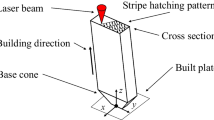Abstract
The aim of this paper was to characterize different classes of materials, light metals, steels, cobalt–chromium-based and ceramic materials under tribological stress and to determine the reproducibility of the measurement results by monitoring the production, processing and analysis of the test materials. The results were used to ensure pre-selection of materials for use in the dry forming process. To depict real conditions at the edges of a forming process surface pressures of 10–200 N/mm2 need to be adjusted. For this purpose, the friction and wear properties were determined in a dry ball-on-disc test. The functional surfaces were produced by laser-cladding, selective laser melting, chemical vapor deposition (CVD) and laser hardening. The tested and selected classes of materials were steel (42CrMo4, X110CrMoVAl 8-2), light metals (aluminum 6082, C95300 aluminum-bronze), cobalt–chromium alloys (Stellite 12, Stellite 21), ceramic (S3N4) and polycrystalline CVD diamond. The test setup of the dry ball-on-disc test included 10 N contact force, 10 mm traversing distance, 10 mm/s average speed, 40 % humidity and 24 °C ambient temperature. The resulting wear map includes five orders of magnitude of different wear rates and one order of magnitude of different coefficient of friction. An eligibility number is introduced for a better differentiation of the combined properties of the tribosystem of a tool material.













Similar content being viewed by others
References
DIN EN 1071-13 (2008) Advanced technical ceramics—methods of test for ceramic coatings—part 13 determination of wear rate by the pin-on-disk method
ÖNROM M 8125 (1994) Tribotechnik—prüfung von reibung und verschleisß—modellversuch: system Kugel-Scheibe
NIST ASD Team (2013) NIST atomic spectra database (version 5.0). National institute of standards and technology, Gaithersburg, MD. http://www.nist.gov/pml/data/asd.cfm. Accessed 17 Feb 2014
BAM (2013) Datenbank tribocollect, datenbank zum tribologischen verhalten von werkstoffen und beschichtungen. http://www.bam.de/microsites/tribocollect/tribocollect_i.htm. Accessed 17 Feb 2014
Vollertsen F, Schmidt F (2014) Dry metal forming: definition, chances and challenges. IJPEM-GT 1(1):59–62. doi:10.1007/s40684-014-0009-0
SFB 442—Umweltverträgliche tribosysteme. http://www.sfb442.rwth-aachen.de/index.html. Accessed 17 Feb 2014
Dias da Silva M, Partes K, Seefeld T, Vollertsen F (2012) Comparison of coaxial and off-axis nozzle configurations in one step process laser cladding on aluminum substrate. J Mater Process Technol 212(11):2514–2519. doi:10.1016/j.jmatprotec.2012.06.011
Koehler H, Partes K, Seefeld T, Vollertsen F (2010) Laser reconditioning of crankshafts: from lab to application. Phys Procedia 5, Part A (0):387–397. Laser assisted net shape engineering 6, proceedings of the lane 2010, Part 1. doi:10.1016/j.phpro.2010.08.160
Schwander M, Partes K (2011) A review of diamond synthesis by CVD processes. Diam Relat Mater 20(9):1287–1301. doi:10.1016/j.diamond.2011.08.005
Partes K, Schwander M (2012) Einfluss von Stickstoff auf die Struktur von polykristallinen CVD-Diamanten. In: Wielage B (ed) Tagungsband zum 15. werkstofftechnischen kolloquium, eigenverlag, chemnitz, vol 47, pp 265–273. ISBN 978-3-00-039358-7
Erdemir A, Switala M, Wei R, Wilbur P (1991) A tribological investigation of the graphite-to-diamond-like behavior of amorphous carbon films ion beam deposited on ceramic substrates. Surf Coat Technol 50(1):17–23. doi:10.1016/0257-8972(91)90187-2
Murakawa M, Koga N, Kumagai T (1995) Deep-drawing of aluminum sheets without lubricant by use of diamond-like carbon coated dies. Surf Coat Technol 76–77, Part 2(0):553–558. International conference on metallurgical coatings and thin films. doi:10.1016/0257-8972(95)02523-5
Zitzler E, Thiele L (1999) Multiobjective evolutionary algorithms: a comparative case study and the strength Pareto approach. IEEE Trans Evol Comput 3(4):257–271. doi:10.1109/4235.797969
Pillay A, Wang J (2003) Modified failure mode and effects analysis using approximate reasoning. Reliab Eng Syst Saf 79(1):69–85. doi:10.1016/S0951-8320(02)00179-5
Acknowledgments
This work was supported by the Deutsche Forschungsgemeinschaft (DFG) under contract no. PA 1859/3-1 and VO 530/75-1 which the authors gratefully acknowledge.
Conflict of interest
None.
Author information
Authors and Affiliations
Corresponding author
Rights and permissions
About this article
Cite this article
Schwander, M., Füller, D., Köhler, H. et al. Pre-selection of laser-processed materials for dry forming tools by means of a dry oscillating ball-on-disc test. Prod. Eng. Res. Devel. 8, 603–611 (2014). https://doi.org/10.1007/s11740-014-0554-y
Received:
Accepted:
Published:
Issue Date:
DOI: https://doi.org/10.1007/s11740-014-0554-y




